Being able to communicate along the length of the boat allows crew to coordinate activities like anchoring, docking, or going up the mast, but to be truly useful, the communication method needs to be hands-free.
Practical Sailor
What We Tested
In the October 2007 issue, Practical Sailor reported on the Mariner 500 headsets from Cruising Solutions. Though affordable ($60 per pair), they proved to be prone to static and bulky to wear. Since then, Practical Sailor has been experimenting with two other hands-free solutions: the Motorola SX800R two-way (Family Radio Service/GMRS) radios, using the voice-activation feature, and Nautic Devices Yapalong 3000. (For a complete description of Family Radio Service, or FRS, and a review of seven different models, see the Jan. 1, 2002 issue or the online version of this article at www.practical-sailor.com.)
Unlike the Mariner 500, which incorporates the radio transmitter and battery into the headset, both the Motorola SX800R and the Yapalong comprise a cell-phone-sized transmitter/radio unit and a separate headset. But they represent two very different solutions for hands-free communication.
How We Tested
Practical Sailor testers put both the Motorola and Yapalong headsets into service aboard several cruising boats, using them to communicate during various activities, including anchoring, masthead repairs, and docking. The products were used in various weather and sea conditions, including light rain and spray, with their mated headsets. The Motorola was also tested with the Fire Fox Sportsman Throat Mic.
Motorola SX800R
A global leader in communications devices, Motorola manufactures cell phones, two-way radios, and their accessories. Like a VHF radio, the Motorola SX800R allows only one person to speak at a time by keying the “push to talk” (PTT) button. Its voice-activation (VOX) technology, which starts transmitting when a voice is detected, improves this simplex operation by eliminating the need to push the PTT button.
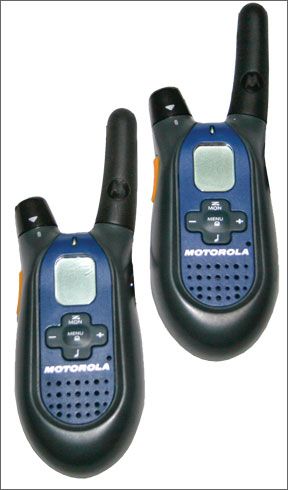
With the addition of a headset and a hands-free way to carry the transmitter (a wide variety of which are available at www.motorola.com), a crewmember can grind a winch or operate a windlass while talking to others on the boat.
The Motorola radios have three drawbacks that result from the combination of simplex operation with VOX technology. First, as with a VHF radio, users can “step on” one another by transmitting at the same time. Second, the voice-activation feature does not respond instantaneously, cutting off the first few words of each transmission. Third, if background noises are loud enough, they can trip the voice activation and prevent other users from transmitting.
The Motorola SX800R is weatherproof, but not waterproof: It has no rubber gasket to protect the electrical components. However, testers did use it in rainy conditions for up to an hour without any ill effect. It is reasonably rugged and survived being dropped from waist height several times.
For onboard communication on most recreational boats, a range of 100 feet is sufficient, but for taking lines ashore, the range needs to extend to 300 to 600 feet. The Motorola SX800R has a reported range of about 2 miles on the FRS channels and up to 16 miles on the GMRS channels. Our testers successfully communicated with the radios at a distance of about a mile with buildings and other obstacles between speakers.
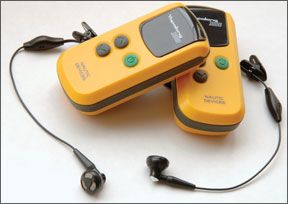
Unlike many onboard communications devices, the Motorola two-way radios also offer NOAA weather-alert radio and have 22 FRS/GMRS channels with a scan mode.
The Motorola SX800R set is relatively inexpensive. For $68, you get two radios, two rechargeable NiMH batteries, and one drop-in wall charger, with a one-year warranty.
Yapalong
Ontario-based Nautic Devices Inc. developed the Yapalong, which uses a 2.4-GHz unlicensed frequency band, to address the drawbacks of FRS communication. It works like a telephone, using duplex operation to join speakers in what is effectively a conference call with up to four active participants. There is no delay because the “line” is always open, so no words are lost at the start of a transmission. Background noises may be distracting, but others can still transmit and be heard over them. Adjustable mic sensitivity also helps ensure clear communication, even when users speak softly.
User group size is limited to four active participants, but the listen-only Yapalong 3000-L allows an almost unlimited number of people to listen in on the conversation.
The robust, waterproof Yapalong withstood being dropped several times from a height of one meter onto a hard surface and being submerged in salt water to a depth of one meter for 30 minutes. A rubber gasket and a watertight seal keep splashes and rain out of the battery compartment and audio jack connector. In the event of submersion, water may enter these areas, but the rest of the unit is epoxy filled and watertight. Yapalong says that rinsing these areas with fresh water and drying the unit thoroughly after submersion will prevent corrosion. Our testers followed these instructions, and six months later, the Yapalong still functioned and showed no signs of corrosion.
The Yapalong is supposed to have an effective range of 800 feet line-of-sight. It is sensitive to body position and works best when oriented toward the other users with no obstructions. In practice, testers found the effective range to be about 150 feet when shielded by a users body, which would normally be the case when working on the foredeck. Our testers also found that after 10 or 15 minutes of use, the low level of static through the earbud became annoying and unpleasant.
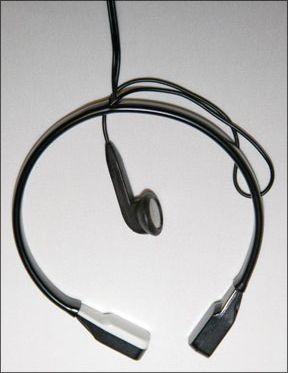
The Yapalong is powered by two AAs or rechargeable NiMH batteries. It does not have a standard charger, and batteries are not included.
At $240 for a pair of headsets, the Yapalong 3000 is considerably more expensive than the Motorola radios. But unlike the Motorola, the package comes with a two-year warranty and includes a microphone, earbuds, adjustable neck strap, and a storage case.
Headsets
The Yapalong comes with a clip-on microphone and earbud speaker; it cannot be used without these. Yapalong voids the warranty if the device is used with non-proprietary headsets.
The Motorola SX800R can be used with a headset or in iVOX mode, which enables voice activation without a headset. For the voice activation to work, the unit must be kept within an inch or so of the speakers mouth-not practical for hands-free use in most situations.
The Motorola SX800R has a standard 2.5-millimeter radio jack and can use a variety of headsets. The Yapalong headset uses a shorter radio jack, so we could not use it with the Motorola SX800R, and we could not use the Motorola-compatible headsets with the Yapalong.
For hands-free operation, we tested the Motorola with two different headsets: the Motorola earpiece with boom microphone (Model 53620) and Fire Fox Technologies Sportsman throat mic. All of the headsets proved problematic in actual use. None was waterproof, and all would fail if worn in a soaking rain.
When clipped to a jacket or shirt within a few inches of the users mouth, the Yapalong clip-on mic worked well. Communication continued easily even when one user was working an electric winch. A hook over the ear keeps tension off the earbud so that it stays in place. This works well if the user remains still. However, field tests showed that any activity-grinding a winch or replacing a light at the masthead-caused the earbud to fall out. The need to continually replace it made
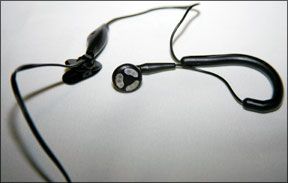
total hands-free operation impossible. In addition, the earbud was too large for our female tester, who could never get it to stay in her ear.
The Motorola headset is similar to those used for hands-free talking on a regular phone. The padded speaker is mounted on a semi-rigid ear hook and fits over the ear instead of seating into it. The foam-covered boom microphone is attached to the headset via a flexible arm. Once positioned comfortably, the headset stayed in place with minimal fussing. The microphone needed to be positioned very close to the mouth to engage the VOX on the Motorola SX800R.
This was the best of the headsets we tested, but we still found three drawbacks: The earpiece could not be worn with glasses, a major problem for those at the bifocal stage of life; the earpiece was dislodged with any sort of aggressive activity; and the mic picks up the noise of the wind in breezes better than about 20 knots, tripping the voice activation.
The Fire Fox Sportsman throat mic has a neck collar with a microphone designed to be positioned next to the users Adams apple and an earbud speaker on a wire. The microphone proved difficult to correctly position, and it slipped out of position with any movement. Even when the microphone was properly positioned, users had to speak quite loudly to engage the VOX technology.
The earbud had nothing to hold it in a fixed position and also fell out with minimal movement. Like the Yapalong earbud, it was too large for our female testers ear. Ear hooks to hold the earbud in place and ear tips to improve the fit are both available at the Fire Fox website (www.firefoxtech
nologies.com) for less than $5. The Sportsman is the least expensive of the Fire Fox line of throat microphones. The more expensive units, which have ear hooks and more sensitive microphones, range in price from $25 to $90 (www.csonline.net).
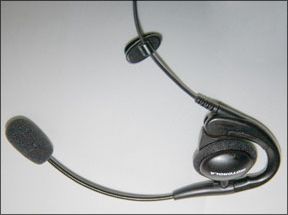
Bottom Line
Practical Sailor has still not found the ideal hands-free, onboard communication system. To be hands free, the earpiece must stay in place through vigorous activity and the microphone technology must reliably transmit what has been said. Each of the options tested failed on one of these points.
While the Yapalong represents a major advance over the less-expensive VOX technology tested, were not convinced it is worth the $240 price tag. The problems with the earbud and the annoying static during transmission make communication too difficult.
The Motorola SX800R with the Motorola earpiece and boom microphone may be a better buy, but the realities of VOX technology and simplex operation make them cumbersome and frustrating to use.
For now, without an effective hands-free solution, testers will communicate either by using hand signals or the two-way radios without a headset. Well remain on the lookout for a cruiser-budget friendly, hands-free solution for onboard communications.
has been on the lookout for reasonably priced, hands-free communication options since the 2006 Americas Cup in Valencia, Spain, when the teams relied on high-tech-and expensive ($600 to $1,000 each)-lightweight wireless headsets.
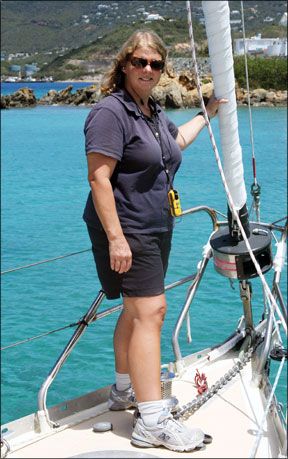
Photos by Beth A. Leonard and Evans Starzinger



































